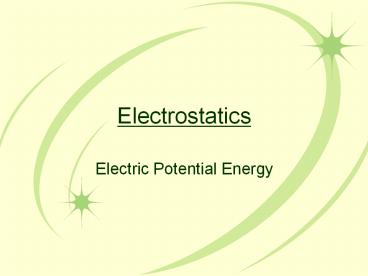Electrostatics - PowerPoint PPT Presentation
Title:
Electrostatics
Description:
Electrostatics Electric Potential Energy Objectives Define electric potential energy and change in electric potential energy Solve 2 point charge problems at rest ... – PowerPoint PPT presentation
Number of Views:263
Avg rating:3.0/5.0
Title: Electrostatics
1
Electrostatics
- Electric Potential Energy
2
Objectives
- Define electric potential energy and change in
electric potential energy - Solve 2 point charge problems at rest involving
- Electric potential energy
- Charge
- Distance of separation
- Moving 2 point charge problems involving
- Change in electric potential energy
- Distance of separation (initial and final)
- Charge
3
Electrical Potential Energy
- Recall equation for electrical force
- FE kQ1Q2/r²
- When we were looking at gravitational forces, how
did we find work done? - Area under the graph.
4
Electrical Potential Energy
Recall thatpotential energyis zero at infinity8
5
Electrical Potential Energy
- EP kQ1Q2/r
- When using the potential energy equation, keep
the following in mind - Amount of potential energy due to separation of
two charged particles by distance r. - Include the signs of the charged particles
- Drop the - sign
6
Electrical Potential Energy
- EP kQ1Q2/r
- Drop the - sign, youll see!
- A particle has its highest energy when close to
another particle - A - particle has its highest energy when far from
a particle - Oppositely charged particles have low energy when
they are close together
At 8 HighestEnergy ie. 0J
Lowest Energyie. -100J
Some Energyie. -50J
Q2
-
-
-
Q2
Q2
Highest Energyie. 100J
Some Energyie. 50J
At 8 LowestEnergy, ie. 0J
7
Electrical Potential Energy Ex 1
- How much potential energy does a 1mC charge have
when it is 1m away from a 5C charge? - EP kQ1Q2/r
- EP (9x109Nm²/C²)(5C)(0.001C)/(1m)
- EP 4.5x107J
Relative tozero at infinity
5C
1mC
1m
8
Electrical Potential Energy Ex 2
- Same 2 particles, how much work is necessary to
move the 1mC charge to 1.5m away? - W ?EP EPf - EPi
- W kQ1Q2/rf - kQ1Q2/ri
- W kQ1Q21/rf - 1/ri
- W (9x109)(5)(0.001)1/(1.5m) - 1/(1m)
- W -1.5x107J
-, so work has been done by charges (energy
work are not vectors)
1mC
1mC
5C
1.5m
9
Conclusions
- Potential Energy EP kQ1Q2/r
- Like charges experience a potential energy that
increase the closer they are together - Opposite charges experience a - potential energy
that decreases the closer they are together - Particles experience zero potential energy when
they are infinitely far apart from one another
10
Electrostatics
- Electric Potential
- Voltage
11
Electrical Potential
- We have already looked at the amount of energy a
charge has - E kQ1Q2/r
- But that is rarely useful, lets look at the
total amount of energy a charge has - ELECTRIC POTENTIAL
12
Electrical Potential
- Electric Potential is also sometimes called just
simply Potential - Symbol is V (Named after Volta)
- Measured in Volts (J/C)
- It is the amount of work required to move a unit
of charge from point A to point B - V EP/q
- V (kQq/r) / q
- V kQ/r
Alessandro Volta - Built the first battery
13
Electrical Potential
- Example Find potential of the -5mC charge at
1.5m and at 5m away? - V kQ/r
- V1.5 (9x109J)(-0.005C)/(1.5m)
- V1.5 -3x107V
- V5 (9x109J)(-0.005C)/(5m)
- V5 -9x106V
-5mC
14
Electrical Potential
- Example Contd What is the potential difference
between 1.5m and 5m? - ?V V5 - V1.5
- ?V (-9x106V) - (-3x107V)
- ?V 2.1x107V
-5mC
V1.5
V5
5m
1.5m
15
Electrical Potential
- From the previous example, consider the
following - ?V Vf - Vi
- ?V EPf/q - EPi/q
- ?V (EPf - EPi)/q
- ?V W/q
- W ?Vq
Work required tomove a chargefrom one
voltageto another
16
Electrical Potential
- Example Contd How much work does it take to
move a 1µC charge from 1.5m to 5m? - W ?Vq
- W (2.1x107V)(1x10-6C)
- W 21 J
1µC
1µC
1µC
-5mC
V1.5
V5
5m
1.5m
17
Conclusions
- Electric Potential, Potential, Voltage
- Same Diff
- Measured in Volts
- V kQ/r
- W ?Vq
- Zero volts is sometimes called ground
- Symbol is































